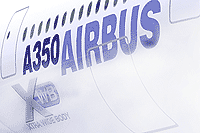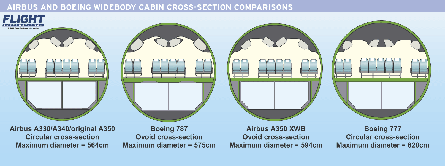By Max Kingsley-Jones at the Farnborough air show
The original A350 is dead. From its ashes rises a bigger design the European manufacturer says is 'entirely new'.
Airbus chief salesman John Leahy was like the cat that got the cream at the Farnborough air show when he finally won clearance to unveil the manufacturer's all-new medium-capacity offering - the "A350 Xtra Wide Body [XWB]".
Leahy was confirming what has been buzzing around the industry bazaars for months - that Airbus had relegated the original A330-derived A350 to the dustbin and started with a clean computer screen. But nothing beats hearing it from the horse's mouth, and Airbus has answered many questions with its A350 announcement, having on the face of it at last created a worthy twin-engined competitor for both the Boeing 777 and 787.
| AIRBUS A350 XWB |
 |
| Airbus unveiled the A350 Xtra Wide Body at the Farnborough air show. This article is one of a series of articles our team wrote from the show. |
| Farnborough: 350 power race ignites |
| Farnborough: Cautious welcome for new A350 |
| Farnborough: GEnx offered for future A330s |
| Farnborough: Finnair first carrier to commit to new Airbus A350 XWB twinjet family |
| Farnborough: Airbus goes for extra width |
The new A350 looks radically different to any previous twin-aisle Airbus, and bears more than a passing resemblance to the new aircraft from Seattle it has been created to defeat. Its US rival has already labelled the new Airbus as nothing more than a "me-too" long-range twinjet - in much the same way Airbus executives first referred to the 787 as a "Chinese copy" of the A330.
Uncertainties remain - including the current lack of a choice of engine suppliers; whether all existing customers will tolerate the increased list prices and rescheduled delivery targets that are two to three years later than previously planned; and how it will raise the estimated €8 billion ($10 billion) development costs, which are almost double those that were projected for the old model.
Going for gold

The details were announced at a packed press conference hosted by Airbus's new chief executive Christian Streiff, who conceded that, although the original A350 had a relatively healthy orderbook (182 commitments from 14 clients), "many of our customers told us we should do better".
He credited the president of the company's "number one customer" - Steve Udvar-Hazy of International Lease Finance - for finally pushing Airbus to design a truly competitive rival to the 787. "Steve Hazy told us 'don't run for the silver medal when you able to run for the gold - give me an aircraft that is ahead of the present standard of the industry'."
Streiff said that the A350 XWB is an "entirely new design" and the "best in-class offering for mid-size and long-range aircraft". He emphasises that the new A350's definition is completed and it is "100% ready" for industrial launch. Streiff said that, as newly appointed chief executive, he wants to take the next "100 days" to look at the programme as part of a company-wide evaluation, but expects the new model to get approval from "both shareholders" for a full go-ahead in the "early days of October".
During this three-month overview, Streiff said he will evaluate "the possibility of a faster ramp-up". He will also conduct a complete review of the supply-chain management and obtain "a full understanding of the exact situation with potential risk-sharing partners".
New baby
Streiff was adamant that during this overview process, the development programme will continue and it will not delay service entry beyond the new mid-2012 target. "We will do everything possible to improve this schedule," he adds.
Given the impressive specification promised by Airbus, it is not surprising that Leahy has been itching to unveil his new baby. The new three-member family that has been evolved over the last seven or eight months has a new wider fuselage cross-section and all-new larger wing, creating what Airbus is convinced is a single, integrated product range that will be able to out-gun both the 787 family and the 777-200ER in a single blow.
The A350 XWB family has three members - the -800, -900 and -1000, seating 270, 314 and 350 passengers respectively, and all offering a range of 15,700km (8,500nm). Maximum take-off weight for the -800 is unchanged at 245t, but the mid-size -900 variant (now the lead model) has grown 20t to 265t while the new -1000 will weigh in at 290t.
Taking time
Further down the road, planned ultra-long-range and freighter variants of the A350-900 will bolster Airbus's armoury in the battle against the 777-200LR and 777 Freighter. The downside is that customers will have to wait until mid-2012 to receive the first aircraft - 18 months later than previously scheduled.
More siblings promised |
|---|
| Airbus will include the planned development of ultra-long-range and cargo variants of the A350-900 family right from the programme launch later this year to enable it to strengthen its product line against the successful 777-200LR/300ER/Freighter. "The ultra-long-range -900R and -900F model will use the engines and structure of the A350-1000, and will enter service around 2015," says Dr Kiran Rao, Airbus executive vice-president marketing and contracts customer affairs. Both models will use the 95,000lb-thrust (420kN) engines and 290t take-off weight of the A350-1000. Rao says that the A350-900F will be able to carry its "full 90t payload over distances in excess of 5,000nm [9,250km]", and although its payload is slightly lower than the 777 Freighter it will offer "25-30% lower costs". The -900R will be able to carry a load of around 310 passengers "1,000nm further than the -900 - 9,500nm - and again offer significant cost savings over the 777-200LR", says Rao. |
"Our customers said 'you're coming out [with the original A350] about three years behind your competitor...why don't you take the time and come out later with a better airplane," said Leahy. "And that's what we've done - come out with an aircraft that is a step ahead of the 787 and a leap ahead of the generation of aircraft that Airbus and Boeing are building today."
Airbus has 100 firm orders for the old A350, and a further 82 commitments, and Streiff says the intention is to convert all these to the new model. Although Leahy was reluctant to talk specifically about any potential pricing changes for existing deals, he said that "it is a much more impressive aircraft, so we will be asking more".
The list price for the new A350-800 variant is $189 million, while the new -900 is $215 million and the -1000 is $242 million. The original -800 and -900 were priced at $154 million and $171 million when quoted last year, which means the new models are 20-25% more expensive. Existing customers look set to resist Airbus's price rises and Leahy conceded he may lose "one or two" of them as part of the renegotiations.
Central to the new design is an all-new wider fuselage with a diameter 31cm (12in) wider than the A330 and 8cm (at armrest) to 13cm (at eye level) wider than the 787, which Airbus said enables it to accommodate slightly wider (48cm) economy seats than its rival. The new design maximises usable volume by having a constant cross-section from door one to door four. "The Airbus taper is no longer there in the back," Leahy said.
For the first time in a twin-aisle Airbus, the fuselage will be a double-lobe ovoid design, with the lower section being essentially the same as the A300/A330/A340 and sized to accommodate two standard LD-3 containers side-by-side.
The redesigned fuselage is capped by a completely new nose with revised, four-piece cockpit windows. Meanwhile, passenger windows are 5cm wider than those on today's A330, making them the "widest on any airliner", said Leahy.
Airbus has not yet fully defined the structure of the new fuselage, but is likely to retain a definition similar to that of the previous A350, which made widespread use of aluminium lithium rather than carbonfibre as specified by Boeing for the 787. "We may also have some 'black metal' composite parts," said Streiff.
The new wing is little changed structurally from the earlier A350's, being made largely from carbonfibre, but with some metallic ribs. However it has greater span and chord, and increased sweep (by 3° to 33°), pushing normal cruise speed up from Mach 0.82-0.83 to M0.85.
Powering up
Leahy said that the new A350's engines will be "more advanced than those on the 787 and planned for the earlier A350", with thrust ranges between 75,000lb (334kN) and 95,000lb. Rolls-Royce "is signed up" for the new programme and Leahy said the new variant derived from the Trent 1000-series engine for the A350 XWB - which will "more than likely" be adapted for bleed - will offer a 2% reduction in specific fuel consumption over the earlier engine.
But General Electric - whose GEnx was the launch engine on the original A350 - is conspicuous by its absence, and has all but ruled out supplying an engine for the largest A350 variant. "We're in discussions looking for a second engine manufacturer," said Leahy, who hints that Engine Alliance - the GE/Pratt & Whitney joint venture that supplies the A380's GP7200 - is one potential candidate.
GE is known to be reticent about powering the largest A350 variant as it would put itself in direct competition with the 777-200LR/300ER for which it is the exclusive engine supplier. But Airbus has recently compiled a new forecast that predicts demand for nearly 6,000 aircraft in the A350's category between 2010 and 2030 and sources say that it hopes to convince GE there is room enough in the market for everyone to compete safely.
Source: Flight International























